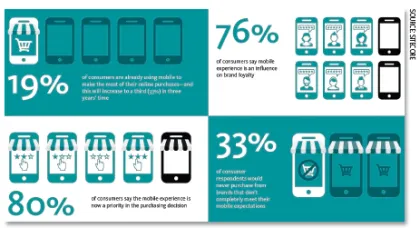
The way forward for commerce: Personalisation and contextualisation
With the growing expectations of consumers, it is now more critical than ever for retailers to be aware of the opportunities that arise and to fully utilise them to their advantage.
During the Lunar New Year this year, retailers at traditional shopping areas such as Chinatown faced declining sales in the face of high rental costs. The mostly wet weather during this period certainly did not help sales, or the lack of them.
While there were exceptions of visible queues, such as at select bak kwa (barbecued pork) stores, many brands synonymous with traditional Lunar New Year goodies have gone online. Yes, even bak kwa.
More and more consumers are reportedly buying new year necessities and traditional goodies online with an easy click. In fact, NTUC FairPrice has reported a surge in online sales leading up to the Lunar New Year. What is evident is that FairPrice’s online shoppers have opted to purchase bulkier items such as packet drinks and canned food online rather than having to queue in line at physical FairPrice supermarkets.
The dawn of the digital consumer era is undoubtedly here but what are key factors, challenges and opportunities in successful e- or m-commerce today?
A study conducted by Sitecore in partnership with Vanson Bourne, Online commerce: Plotting a course to personalisation, reveals the challenges that brands face in delivering contextual commerce and the need for content and commerce to coexist in one digital marketing platform.
TechCrunch defines contextual commerce as the concept where merchants seamlessly implement purchase opportunities into everyday activities and natural environments. Consumers can thus purchase anything, anytime and anywhere, at just the click of a button.
Among the findings of the study is that brands are not maximising the benefits of online commerce despite its growing importance. A huge reason, the study says, is because brands are struggling to create a consumer experience that is both relevant and personalised to each individual consumer — something that shoppers are increasingly expecting today.
With the growing expectations, as well as exclusive online collections and discounts available, it is now more critical than ever for retailers to be aware of the opportunities that arise and to fully utilise them to their advantage. The study reveals that, unfortunately, that is not the case yet.
That brands and marketers are not fully seizing the day means that huge opportunities (and possibly the likewise amount of commerce) are lost for them. This may especially be evident in that 93% of global consumers say that they would take action as a result of unmet expectations by brand-switching, requesting compensation or even becoming a lost customer.
The following are some of the statistics of the online commerce study, especially the key findings for the Singapore market.
Spending habits in relation to online sales
Singapore is one of the more conservative markets when it comes to anticipating the growth of online sales in the next 12 months — despite more than two-thirds (68%) of surveyed decision makers from Singapore anticipating growth, this is still lower than the global figure (81%), and Singaporean respondents are only predicting an average increase of 3.90% (global 5.59%).
According to the study, this conservative attitude could explain why respondents in Singapore indicated that their organisations are spending more than half a million dollars less (US$1.07 million) annually than the global average (US$1.62 million) on their online commerce channels.
The study adds that the respondents’ organisations in Singapore are spending an average of just over 14% of this money on creating and managing the digital user experience, which conforms to the global average of just over 14%.
Challenges remain
The study notes that the majority (94%) of surveyed decision makers in Singapore who are managing at least part of the implementation and ongoing management of their online sales channels in-house are encountering challenges with the evolution of these channels, which is similar to the global figure (95%).
A challenge that is reported to be slightly less common in Singapore (41%) than other parts of the world (43%) is website security. However, the study adds that the proportion of respondents’ organisations in Singapore (41%) that are still seeing the cost of evolving their online sales channels as a challenge is slightly higher than the global average (36%).
On the other hand, those surveyed from Singapore (19%) are shown to be far less likely to report that accommodating and integrating product or services catalogue data into online commerce processes as a challenge than their global counterparts (32%).
The study shows that they are likely (22%) than the global average (25%) to be experiencing the implementation of desired personalisation features as a challenge. This implies that while basic problems such as cost and security are still troubling, these respondents are not encountering the more complex challenges that organisations from other markets are.
Too narrow a focus?
Decision maker respondents in Singapore are just as likely (Singapore 50%; global 51%) to rate their organisation as most successful at the “during purchase” phase of the purchase process, in comparison to pre-purchase (Singapore 33%, global 27%) and post-purchase (Singapore 13%, global 20%) phases.
While respondents from Singapore are more likely to identify “during purchase” as the part of the purchase process they feel is most important to be successful at (Singapore 38%, global 45%), they also demonstrate an understanding that the pre-purchase (30%) and post-purchase (30%) phases are still important (global 30% and 23% respectively).
Web content management (WCM) systems and challenges
Singapore (83%) is ahead of the curve (global 70%) when it comes to respondents’ organisations employing a Web content management (WCM) system, says the study. Nonetheless, 30% are looking to change the system that they are currently using.
Around two-thirds (67%) of respondents’ organisations in Singapore are able to use their WCM to manage the customer experience during and after the sale, which conforms to the global average (67%). Still, these organisations are shown to be struggling to personalise the purchasing experience for customers during and after the sale, with almost seven in 10 (67%) seeing this as a challenge when using their WCM (global 36%).
This seems to be contradicted by the fact that, according to the study, only 30% of Singaporean decision makers reported that their organisation lacks insights into the purchasing experience during and after the sale (global 33%), suggesting that other challenges are causing these personalisation difficulties.
This could be explained by the fact that a higher proportion of respondents from Singapore (42%) reported a disconnect between the data collected from their WCM system and their commerce system, compared to the global figure (34%).
The true value of WCM
The belief that a fully comprehensive digital marketing system would significantly improve online sales efficiency is slightly weaker in Singapore (88%) than the rest of the world (93%), but surveyed decision makers from Singapore (78%) are just as likely as their global counterparts ( 77%) to appreciate the benefits of only requiring one system rather than multiple tools.
The study shows that Singapore respondents are also likely to say they see value in a fully comprehensive digital marketing system. For instance, eight in 10 (80%) agree that such a system would increase their revenues (global 82%).
However, only about two-thirds (68%) of these respondents feel that customer loyalty can be retained through a digital marketing system that focuses on brand experience for customers, which is slightly less than the global average (73%).
To sum up some of these findings, Julia Lee, general manager, Sitecore South-east Asia, says: “Consumers in Asia are now expecting a seamless online purchasing journey, as well as personalised and targeted content, making it more important than ever that brands deliver the right experience to retain brand loyalty and conversion.”
She adds: “It is now more crucial than ever for brands to focus on this area and to bridge the gap between content and commerce, which is primarily driven by the complexity of technology integration. This is what Sitecore aims to do — help brands market in the context of their consumers’ needs and interactions.”



















 Advertise
Advertise







